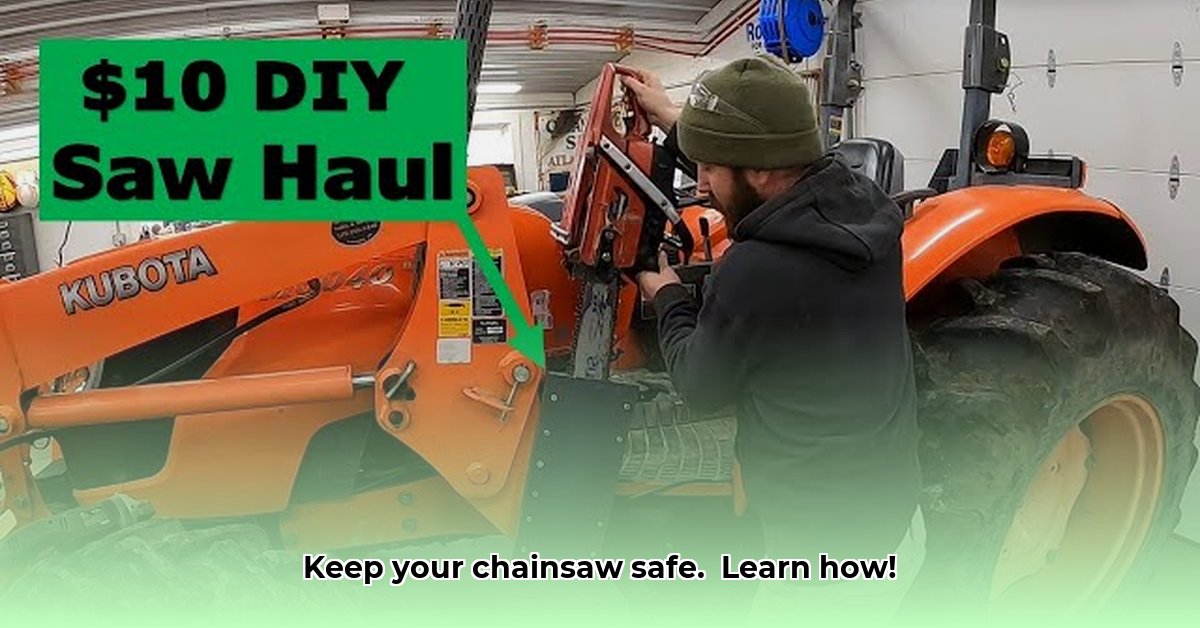
Tractor Chainsaw Scabbard: Enhancing Safety and Efficiency
A loose chainsaw on a tractor presents a significant safety hazard and reduces workflow efficiency. Constantly reaching for or readjusting an unsecured chainsaw wastes valuable time and increases the risk of accidents. This guide focuses on the SawHaul chainsaw carrier, providing a comprehensive overview of its features, installation, maintenance, troubleshooting, and safety considerations to ensure safe and efficient chainsaw use. For more tractor tools, check out this helpful resource.
Introducing the SawHaul Chainsaw Carrier
The SawHaul addresses the problem of unsecured chainsaws by providing a secure and readily accessible storage solution. It significantly enhances safety by preventing accidental drops, damage, and entanglement, while simultaneously improving workflow efficiency. This translates to a safer and more productive work environment. Isn't peace of mind worth the investment?
SawHaul Product Overview: Features and Specifications
The SawHaul typically utilizes durable, UV-resistant plastic construction designed to withstand the rigors of outdoor use. Its design aims for compatibility with most major chainsaw brands. However, conflicting reports regarding chainsaw size limits (20" vs. 36") highlight the importance of checking manufacturer specifications before purchasing. This variance likely reflects different SawHaul models or misinterpretations of product information. Always confirm the compatibility with your specific chainsaw. High-quality images and a video demonstrating installation and secure chainsaw storage would be beneficial additions here.
Step-by-Step SawHaul Installation Guide
Proper installation is crucial for both safety and performance. While generally designed for universal compatibility, some modifications might be necessary, especially on John Deere models.
- Site Selection: Identify a robust, easily accessible mounting point on your tractor's frame. Consider the ideal location for convenient chainsaw access during operation.
- Bracket Attachment: Securely fasten the SawHaul bracket to your chosen mounting point using the provided hardware. Ensure a tight, stable fit to prevent movement during operation. Overtightening should be avoided to prevent damage.
- Scabbard Installation: Attach the chainsaw scabbard to the mounted bracket according to the manufacturer's instructions. This typically involves a simple, secure fastening mechanism.
- Functionality Test: Before commencing work, place your chainsaw in the scabbard to confirm a secure and snug fit. Gently maneuver the tractor to ensure the chainsaw remains firmly in place throughout operation.
- John Deere Modifications (if applicable): Some John Deere models may require additional modification kits for optimal compatibility. Consult the SawHaul manufacturer's website or customer support for specific model guidance.
SawHaul Compatibility Chart: Tractor and Chainsaw Matching
This chart provides crucial compatibility information to ensure a proper fit for your equipment:
| Tractor Brand | Model Examples | Chainsaw Bar Size (inches) | Mounting Notes |
|---|---|---|---|
| John Deere | 5075E, 5083E, 5090E, etc. | 20-30 (varies by model) | May require specific mounting brackets |
| Kubota | BX2380, L2501, etc. | 18-24 | Generally straightforward installation |
| Massey Ferguson | 135, 150, 175, etc. | 16-22 | Check for suitable mounting points near the seat |
| Other Brands | Many makes and models | Refer to SawHaul's Website | Compatibility is likely; verify via website |
Note: This table is for guidance. Always verify compatibility with the SawHaul manufacturer's website or contact them directly.
SawHaul Maintenance and Care: Extending Product Lifespan
Regular maintenance is essential to maximize the lifespan of your SawHaul.
- Cleaning: Regularly clean the scabbard with mild soap and water after each use.
- Storage: Store indoors when not in use to protect it from the elements.
- Hardware Inspection: Periodically inspect all bolts and fasteners to ensure they remain secure and replace any worn parts.
Troubleshooting Common SawHaul Issues
- Chainsaw Fit: If your chainsaw doesn't fit, double-check compatibility with the SawHaul model and ensure proper scabbard attachment.
- Loose Scabbard: Tighten any loose bolts or screws. Inspect for any damage to the bracket or scabbard.
- Bracket Damage: Check the mounting hardware for damage. Replacement parts may be necessary.
Safety Precautions: Prioritizing Your Well-being
Always prioritize safety:
- Secure Chainsaw: Ensure the chainsaw is securely fastened in the scabbard before operating the tractor.
- PTO Disengagement: Disengage the power take-off (PTO) before mounting or removing the chainsaw.
- Personal Protective Equipment (PPE): Always wear appropriate PPE, including eye protection, hearing protection, and gloves.
Conclusion: A Safer, More Efficient Work Environment
Investing in a SawHaul chainsaw carrier offers a tangible improvement in safety and efficiency. By following this guide, users can ensure proper installation, maintenance, and responsible operation. A secure chainsaw equates to a safer and more productive workday.